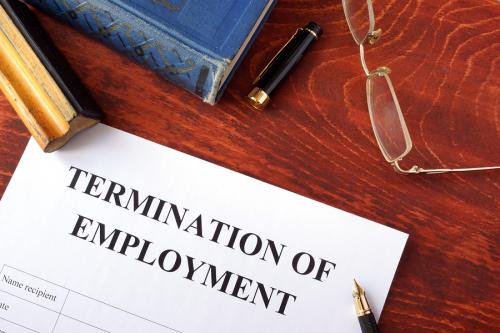Below is a review of the posts (on Facebook, LinkedIn, and Twitter) from the past week. You can check out the full posts by clicking on the links.

In the post on Sunday 7/31/2022 we discussed the impact of COVID on employer responsibility under the WARN Act. One company did so: US Well Services, Inc., a hydraulic fracturing (“fracking”) business. In early March 2020, oil prices plummeted. As a result, several customers abruptly discontinued fracking work at several sites. On March 18, 2020, US Well notified hundreds of employees that they were immediately laid off “due to unforeseeable business circumstances resulting from a lack of available customer work caused by the significant drop in oil prices and the unexpected adverse impact that the Coronavirus has caused.” The employees filed WARN Act claims in federal court. US Well moved for judgment in its favor; its argument is noted in the post. The workers also sought judgment in their favor; their argument is also in the post. The trial court denied both motions. The workers filed an interlocutory (interim) appeal. In a unanimous decision issued June 15, 2022, the appellate court held that “the COVID-19 pandemic is not a natural disaster under the WARN Act.”(The case cite is in the post). This first-of-its-kind U.S. appellate decision distinguishes natural disasters from diseases, pandemics, and viruses; what it said about the difference, and how that is reflected in the statute, is in the post. And why do (or should) employers care about this? It is a large obstacle to reliance on COVID-19 and its resultant issues as the sole or even primary justification for not giving sufficient notice of termination for WARN Act purposes. You know, the notice that nobody without a crystal ball could have given early on during the pandemic. The potential financial impact to employers? See the post.
TAKEAWAY: The pandemic has made the legal system pivot, but that does not mean that existing laws have fallen by the wayside; to the contrary, most still apply, but perhaps with an overlay or twist. Know the law.

The post on Monday 8/1/2022 asked: employee or independent contractor? That is a very important question. Whether someone is an employee or independent contractor has huge ramifica-tions for employers. Both classifications get paid to perform work, but One example, having to do with FLSA coverage, is noted in the post. Why is this at the forefront now/again? The recent boom in remote work arrangements and the gig economy — short-term jobs. On June 3, 2022, the U.S. DOL announced it intends to engage in another rule-making on determining the classification of workers (i.e., employee or independent contractor). What happened relative to a prior DOL rule is noted in the post, including DOL’s appeal and the new rule-making. Many hope that the new rule will continue to reaffirm the traditional “economic reality” test (which is defined in the post). Most courts already use that test or something similar. But DOL’s rule identifies two new “core factors” to help determine whether the workers are independent contractors; those are listed in the post and try to work through whether gig economy workers are employees or contractors. An example of this is the federal case in Pennsylvania a few years ago. See the post for details on that and the outcome. DOL’s rule also identifies three other factors that can be use when the two “core factors” do not resolve the question. Those 3 factors are also listed in the post. DOL says that the focus should be on the actual working relationship and not what may be contractually or theoretically possible. So what is a careful employer to do during all of this legal wrangling? One red flag that invites DOL scrutiny is hiring former employees under the title of independent contractor to perform the same job as they did before. Two more red flags are noted and described in the post.
TAKEAWAY: Get it right from the start: work with an employment lawyer on proper classification of your workforce.

The post on Tuesday 8/2/2022 told us that Green Lantern and Pullman Associates will pay $60,000 to settle EEOC sexual harassment suit. The two companies own and operate the Mr. Dominic’s on Main and Mr. Dominic’s at the Lake restau-rants in Rochester, New York. According to the lawsuit, Rachel Clifford and other female employees were subjected to a hostile working environment by a male head chef and kitchen manager, including sexually explicit derogatory comments and threats of physical harm. When the employees opposed the male chef’s conduct, they were retaliated against as noted in the post. The suit also alleges other failures and actions by Mr. Dominic’s (resulting in termination of employment) that are in the post. Conciliation failed so the EEOC filed suit. The settle-ment involves not only a monetary payment, but significant non-monetary relief as part of the five-year consent decree. That part includes an injunction prohibiting future discrimination and much more as listed in the post. Further, the EEOC will monitor Mr. Dominic’s compliance with its obligations during the consent period.
TAKEAWAY: Train your employees – their actions, or lack of actions, can be costly to you as the employer.

The post on Wednesday 8/3/2022 told us a court ruled for removal of 4 HOA Board members. This was a strange but interesting situation that took years to get to this point. Guillermo Castro Jr., Petra Castro, Andres Perez, Vanessa Perez, and Pedro Balles-teros were looking forward to that day for years. Not only were some Board members removed, but they are also prohibited from having anything to do with decisions made on behalf of either of the associations now or in the future. Who was removed? Albert Muller, III, Albert Muller, Jr., Virginia Muller, and Greg Ebe. Same last name (for 3) so probably a family, right? Yes. The developers. Who just would not cede control. See more in the post.
TAKEAWAY: This would have turned out the same in PA (removal of the developer’s Board members) but for different reasons. Know the law and engage a community associations lawyer.

In the post on Thursday 8/4/2022 we saw a community shares concerns after HOA asks for $11,000 each for grass and tree removal. Owners were notified that they might each have to pay about $11,000 to the HOA to rip out the community’s natural landscaping and replace it with something drought friendly. Why? HOA representatives said it is the result of a state law effective 2021. What the law provides is noted in the post (along with the deadline for compliance). The HOA sent a statement regarding potential charges to owners: “This issue has been discussed with the Villa homeowners ever since AB356 was first being considered by the state legis-lature. Nothing has been decided….” See the post for the full statement.
TAKEAWAY: Know the possible effect of laws on your condo or homeowners’ association – and what must be done to comply and the cost. (Get legal assistance if needed.)

The post on Friday 8/5/2022 was about the top 5 most common wage and hour law mistakes businesses make. Many new (and already-operating) businesses make common mistakes when it comes to how they pay and classify their employees; those mistakes can put them at risk for wage and hour lawsuits and hefty penalties. Updated DOL guidance (and possible rule-making) on this subject were in our post on Monday 8/1/2022. So what are the 5 big mistakes to avoid? First, don’t just pay everyone a salary. It might seem easier to not have to clock in and out or take the time to research and purchase timekeeping software or a “timecard system”. But under federal law, everyone is NOT the same. There are only 5 groups of employees who actually can be paid a set salary regardless of how many hours they work; those categories are listed and explained in the post. The second mistake is not having employees report their time worked. Some of the reasons an employer might make this mistake are noted in the post. But why should the employer keep time records for all employees? The biggest reason is if they make Mistake #1 and misclassify someone as exempt from overtime pay when they are not, there will be records to calculate how much is owed to the worker. If an employee files a wage suit and asserts a certain amount due for overtime work and you cannot disprove their allegations … you can see where this is going. The other 3 mistakes, along with why it the mistakes might be made and reasons not to make them, are in the post.
TAKEAWAY: know how to properly classify and pay workers – get advice form an employment lawyer and follow it.

Finally, in the post yesterday 8/6/2022, we saw an Applebee’s franchisee grilled with sexual orientation, race discrimination lawsuit. The operator of a restaurant in Plant City, FL, agreed to pay $100,000 to settle the lawsuit. The suit alleged that two restaurant staff verbally harassed a Black employee by continuously subjecting him to racial and homophobic epithets (and more as noted in the post). The employee complained to the restaurant management, yet nothing was ever done. The employee then attempted to contact the corporate offices. What happened as a result? See the post. The settlement, which includes a multi-year consent decree, involves the monetary relief noted at the outset plus other non-monetary provisions listed in the post.
TAKEAWAY: take action to correct a work environment containing racial and homophobic slurs and don’t punish any employee who reports harassment.

 York, Pennsylvania 17403
York, Pennsylvania 17403